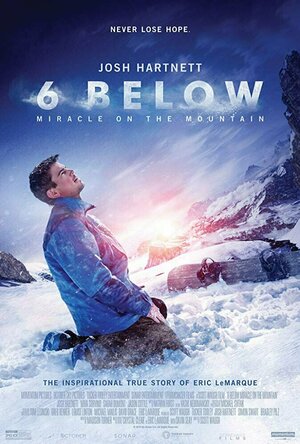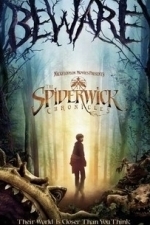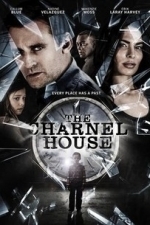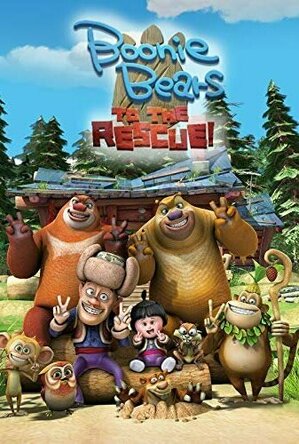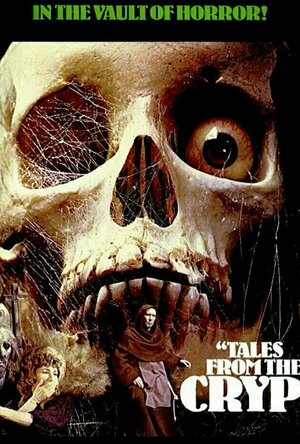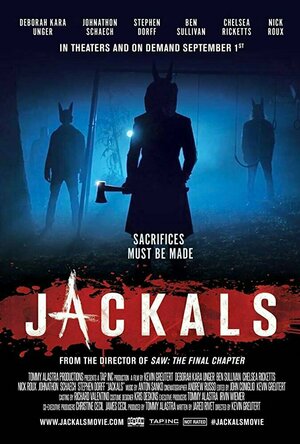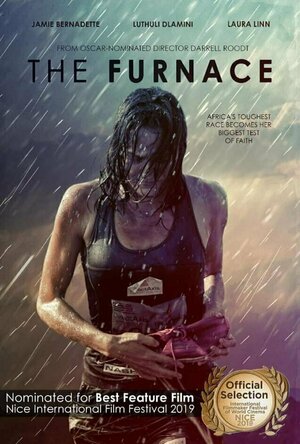Search
Search results
Darren (1599 KP) rated 6 Below: Miracle on the Mountain (2017) in Movies
Oct 2, 2019
Characters – Eric LeMarque had a future as one of the top ice hockey players, he threw this away with hiss reckless behaviour which has seen his career all but gone. With his addiction taking over his life, he finds himself hitting rock bottom and needing to find some hope. Heading for a snowboard away from the world he ends up lost in the harsh wilderness doing everything he can to survive in the conditions which will test his desire to get over his addictions and rebuild his life. Susan is his mother, she has always supported her son and will do anything to help him put his life back on track and is the first to notice he hasn’t been heard from for days. Sarah is one of the rescue team on the mountain, she leads the search once they learn that Eric is missing.
Performances – Josh Hartnett in the leading role does a good job, even if it feels slightly mis-cast because you get the feeling Eric was a lot younger than Hartnett. Mira Sorvino and Sarah Dumont are both solid in the supporting roles as we see them both needing to make difficult decisions.
Story – The story here follows the incredible survival story of Eric LeMarque as he faces days lost in the snow-covered mountain range without anyone searching for him for days, while also battling his own demons of addiction. The story itself is based on the real events that happened to the man who needed to rebuild his life. This does show us just how hard the survival was, though it just doesn’t become the truly engrossing story it could have been, because anything that happens is something we have seen before, be it wolves or injuries. Eric isn’t the most likely guy either because anyone that throws away a sporting career for drugs frustrates the audience. The rescue side of the film either needed to be a bigger involvement or not involved at all, we simply don’t get enough focus on what is happening on this side of the film.
Adventure/Biopic – The adventure side of the film shows us just what could go wrong for an ambitious rush can turn into a battle to survive. The biopic side of the film shows us the days which Eric is lost in the harsh snowy mountain conditions as he battles to survive and his own demons.
Settings – The film puts us in the mountain range covered in snow, showing us how easy it could be to become lost and how hard it would be to survive.
Scene of the Movie – The climb.
That Moment That Annoyed Me – Hartnett feels too old for this role.
Final Thoughts – This is a by the book survival story, it does show an incredible fight to survive and does give us a form of redemption for a young man who was throwing his life away.
Overall: By the books survival film.
Rating
Performances – Josh Hartnett in the leading role does a good job, even if it feels slightly mis-cast because you get the feeling Eric was a lot younger than Hartnett. Mira Sorvino and Sarah Dumont are both solid in the supporting roles as we see them both needing to make difficult decisions.
Story – The story here follows the incredible survival story of Eric LeMarque as he faces days lost in the snow-covered mountain range without anyone searching for him for days, while also battling his own demons of addiction. The story itself is based on the real events that happened to the man who needed to rebuild his life. This does show us just how hard the survival was, though it just doesn’t become the truly engrossing story it could have been, because anything that happens is something we have seen before, be it wolves or injuries. Eric isn’t the most likely guy either because anyone that throws away a sporting career for drugs frustrates the audience. The rescue side of the film either needed to be a bigger involvement or not involved at all, we simply don’t get enough focus on what is happening on this side of the film.
Adventure/Biopic – The adventure side of the film shows us just what could go wrong for an ambitious rush can turn into a battle to survive. The biopic side of the film shows us the days which Eric is lost in the harsh snowy mountain conditions as he battles to survive and his own demons.
Settings – The film puts us in the mountain range covered in snow, showing us how easy it could be to become lost and how hard it would be to survive.
Scene of the Movie – The climb.
That Moment That Annoyed Me – Hartnett feels too old for this role.
Final Thoughts – This is a by the book survival story, it does show an incredible fight to survive and does give us a form of redemption for a young man who was throwing his life away.
Overall: By the books survival film.
Rating
Darren (1599 KP) rated The Spiderwick Chronicles (2008) in Movies
Oct 2, 2019
Characters – Jared is the out going of the twins, he is the one that reads the book and must convince the rest to fight back against goblins, his nature means people are less likely to believe him through any of his decisions though. Simon is the quieter and smarter brother that must look for the solution to the problems being caused. Helen is the mother that is dealing with raising the three children after her marriage has fallen apart and she needs to start a new life, one she isn’t prepared for. Mallory is the older sister that must be the warrior for the twins. Mulgarath is the goblin king that wants the book to kill any species in the surrounding area.
Performances – Freddie Highmore takes twin roles here and handles them both very well showing how he can be the smarter kid and the adventurous one too. Mary Louise Parker in the parental role works well as we need her to bring the serious side to the story now. Sarah Bolger is strong too needing to be the strongest member of the children.
Story – The story takes three siblings into a battle with goblins with fantasy creatures being used to guide the way in this battle. This will bring the broken family back together, well back to the level they are going to need to get used too. The scale of the book doesn’t give the story enough credit because it feels like this book has created a massive world only for us to get a snippet into everything. this story doesn’t re-invent the wheel because we can see the formula unfold without needing to guess to much on just how thing go on. We do deal with a big family change which should be the focal point through the film too.
Adventure/Fantasy – The adventure side of the film takes the family into battle against the creatures of the forest which are invisible to most of the world, this plays into the fantasy side too because of the creatures we see at war.
Settings – The film takes the family to a new house that is in the middle of the forest, which shows us the finical change the family must take, as well as the adventures waiting in the forest for people to experience.
Special Effects – The effects in the film are strong for the most part because we get to see the different creation looking like they would fit in the normal world.
Scene of the Movie – Come with me.
That Moment That Annoyed Me – Not getting a full grasp of the scale of the fantasy world.
Final Thoughts – This is a fun fantasy adventure that brings the characters into a world which will unite them as they deal with the biggest change of the children’s life.
Overall: Simple and enjoyable.
Performances – Freddie Highmore takes twin roles here and handles them both very well showing how he can be the smarter kid and the adventurous one too. Mary Louise Parker in the parental role works well as we need her to bring the serious side to the story now. Sarah Bolger is strong too needing to be the strongest member of the children.
Story – The story takes three siblings into a battle with goblins with fantasy creatures being used to guide the way in this battle. This will bring the broken family back together, well back to the level they are going to need to get used too. The scale of the book doesn’t give the story enough credit because it feels like this book has created a massive world only for us to get a snippet into everything. this story doesn’t re-invent the wheel because we can see the formula unfold without needing to guess to much on just how thing go on. We do deal with a big family change which should be the focal point through the film too.
Adventure/Fantasy – The adventure side of the film takes the family into battle against the creatures of the forest which are invisible to most of the world, this plays into the fantasy side too because of the creatures we see at war.
Settings – The film takes the family to a new house that is in the middle of the forest, which shows us the finical change the family must take, as well as the adventures waiting in the forest for people to experience.
Special Effects – The effects in the film are strong for the most part because we get to see the different creation looking like they would fit in the normal world.
Scene of the Movie – Come with me.
That Moment That Annoyed Me – Not getting a full grasp of the scale of the fantasy world.
Final Thoughts – This is a fun fantasy adventure that brings the characters into a world which will unite them as they deal with the biggest change of the children’s life.
Overall: Simple and enjoyable.
Darren (1599 KP) rated The Charnel House (2016) in Movies
Oct 14, 2019
Characters – Alex Reaves is the man behind the refurbishment of the building, he sees this as a fresh start for his family which will give them financial support for life, he starts having visions which will bring the connection back to the previous owner. Charlotte is the artist and designer (I think she did this too) who has help turn the building into the apartments and soon becomes the one that needs to fight to keep her family together. Mia is the daughter of the couple who starts seeing the little boy haunting the building, treated like the imaginary friend for the most part, she has behavioural problems and follows in her mother’s artistic nature. Devin Pyles is the man that has a connection to the previous use of the building, he is here to investigate just what happened here and knows about the darker side of the building.
Performances – Callum Blue in the leading role is fine without ever standing out in the leading role, which is going to be a theme when looking at the performances, nobody does anything to make themselves feel stand out in the film.
Story – The story here follows the re-opening of an old slaughterhouse as luxury apartments, but the ghosts of the old building are still there haunting the people that move in. this does give us the limited characters as the building isn’t officially opened, but will let people move into the property they have purchased early, this helps the story because an over crowded building would have only dragged the film down. The story is trying to be clever with certain connections only to fall mostly short with this side of the story telling. Once you do work out where the story wants to go you will work out the ending pretty easily which again disappoints and as for the supporting characters they seem to have no connection to the actual hauntings and are here just to give us a body count.
Horror – The horror in the film comes from the ghost visits and the technology not following the rules it should be, again simple scares which don’t give us anything to be frightened off.
Settings – The film is set in one house, we have an apartment building with history which gives us the haunting side of the film. it works well for the most part too.
Special Effects – The effects are not over used, they are simple when needed but nothing that becomes clear to what is happening in the film.
Scene of the Movie – Butch the Yorkie.
That Moment That Annoyed Me – The pointless disposable supporting residents.
Final Thoughts – This is a very simple horror, it does the basics right without ever being put in the position of being anything special or standout, nothing is terrible, it is just average throughout.
Overall: Average horror.
Performances – Callum Blue in the leading role is fine without ever standing out in the leading role, which is going to be a theme when looking at the performances, nobody does anything to make themselves feel stand out in the film.
Story – The story here follows the re-opening of an old slaughterhouse as luxury apartments, but the ghosts of the old building are still there haunting the people that move in. this does give us the limited characters as the building isn’t officially opened, but will let people move into the property they have purchased early, this helps the story because an over crowded building would have only dragged the film down. The story is trying to be clever with certain connections only to fall mostly short with this side of the story telling. Once you do work out where the story wants to go you will work out the ending pretty easily which again disappoints and as for the supporting characters they seem to have no connection to the actual hauntings and are here just to give us a body count.
Horror – The horror in the film comes from the ghost visits and the technology not following the rules it should be, again simple scares which don’t give us anything to be frightened off.
Settings – The film is set in one house, we have an apartment building with history which gives us the haunting side of the film. it works well for the most part too.
Special Effects – The effects are not over used, they are simple when needed but nothing that becomes clear to what is happening in the film.
Scene of the Movie – Butch the Yorkie.
That Moment That Annoyed Me – The pointless disposable supporting residents.
Final Thoughts – This is a very simple horror, it does the basics right without ever being put in the position of being anything special or standout, nothing is terrible, it is just average throughout.
Overall: Average horror.
Darren (1599 KP) rated Boonie Bears: To The Rescue (2019) in Movies
Oct 14, 2019
Characters – Logger Vick has been working on cutting down the trees in the forest, which has seen him become rivals with a couple of bears, his rivalry has seen him spending more time trying to allude the bears, than dealing with his actual job, when his latest equipment is take by the bears, he learns a new responsibility when he must take care of a baby who has become lost in the forest. Briar is the smarter of the two bears, he always has a plan in mind and lets Bramble learn his correct place in the couple’s plans. Bramble does focus on getting most the laughs between the bears, he is meant to be the dumber of the two which comes off clear, with how he deals with keep Lola happy. Lola is the baby that ends up under the care of the unlikely partnerships between bitter rivals.
Story – The story here follows the unlikely union of the television show character Logger Vick and the brother bears Briar and Bramble as they want to protect a little baby girl they find in the forest, who is being tracked down by criminals. If you have seen the TV show, you will enjoy seeing the unlikely union, think Bugs Bunny working with Elma Fudd. If you haven’t seen the TV show you will see how characters similar to Yogi Bear and Ranger Smith clash over certain things. Having this mixed together we do get a Monsters Inc environment, with the baby being thrown into the hands of people and animals with no idea how to raise them and them finding comical ways to make her happy. This is clearly marketed for a younger audience and you can see why they would be happy to sit and enjoy the characters adventures.
Adventure/Family – The adventure side of this film shows us just how far the unlikely group will go to save a baby, it has plenty of references to other adventure films too, while this might be one that is targeted more for the younger members of the family, parents could enjoy watching with their single figured aged children.
Settings – The film uses the settings to get an extra laugh here and there, as it shows us just how the three characters live with their own rivalry.
Animation – The animation in the film does look like it has come from a TV show, which still makes it look fantastic throughout.
Scene of the Movie – The bonding between the three.
That Moment That Annoyed Me – Being unsure what the rivalry between Logger Vick and the bears really is.
Final Thoughts – This is a fun family comedy that will keep the younger audience happy throughout the film, it does have a big heart at the centre and could be compared to Monsters Inc and Yogi Bear with ease.
Overall: Fun family animation.
Story – The story here follows the unlikely union of the television show character Logger Vick and the brother bears Briar and Bramble as they want to protect a little baby girl they find in the forest, who is being tracked down by criminals. If you have seen the TV show, you will enjoy seeing the unlikely union, think Bugs Bunny working with Elma Fudd. If you haven’t seen the TV show you will see how characters similar to Yogi Bear and Ranger Smith clash over certain things. Having this mixed together we do get a Monsters Inc environment, with the baby being thrown into the hands of people and animals with no idea how to raise them and them finding comical ways to make her happy. This is clearly marketed for a younger audience and you can see why they would be happy to sit and enjoy the characters adventures.
Adventure/Family – The adventure side of this film shows us just how far the unlikely group will go to save a baby, it has plenty of references to other adventure films too, while this might be one that is targeted more for the younger members of the family, parents could enjoy watching with their single figured aged children.
Settings – The film uses the settings to get an extra laugh here and there, as it shows us just how the three characters live with their own rivalry.
Animation – The animation in the film does look like it has come from a TV show, which still makes it look fantastic throughout.
Scene of the Movie – The bonding between the three.
That Moment That Annoyed Me – Being unsure what the rivalry between Logger Vick and the bears really is.
Final Thoughts – This is a fun family comedy that will keep the younger audience happy throughout the film, it does have a big heart at the centre and could be compared to Monsters Inc and Yogi Bear with ease.
Overall: Fun family animation.
Darren (1599 KP) rated Tales From the Crypt (1972) in Movies
Oct 14, 2019
Characters – Where this film is an anthology we don’t get too much time with each character, Joanne is a married woman with her own desires for life, showing a darker side after killer her husband on Christmas Eve. Carl Maitland is a married man that is planning on leaving his wife and children, he is involved in an accident which brings into a new lease of horror. Grimsdyke is an older man, he has lived with his wife in one home, with her passed away he wants to die in this house and must deal with the snotty neighbours that is trying to force him out. Jason is a businessman that has spent more than he has earnt forcing him to face bankruptcy for his actions. Rogers is the final story as a manager of home, he comes in with his strict ideas struggle to connect with the people he is meant to be caring for.
Performances – By being an anthology the stars only get limited time, Joan Collins gets the ball rolling as is good in her role with us believing how calculated her actions are. Ian Hendry is solid in his role, he is behind the camera for the most part making it hard to believe everything. Peter Cushing shines as the kindly old man that is getting pushed out of town. Richard Greene is solid enough without getting too much time to show us what makes his character unique. Nigel Patrick does make this character one of the more unlikable with ease.
Story – The story here takes us down the horror anthology line, we get to see five stories of five characters deaths, this does give us something different in each side of the horror scale, we know some are shorter than others with Blind Alleys and Poetic Justice being the stand out of the five stories. There is a big twist in the connection to the stories, but if you do know the TV show you will know the outcome. For a horror anthology this is everything you need without being to the extremes they go nowadays. Each short could easily become a longer film which is always positive.
Horror – When it comes to horror we sometimes get to best moments in shorts, anthologies give us a chance to experience different types of horror which will offer something for all horror fans.
Settings – Each film takes us to the world where the character comes from which shows us how the normal lives they live have the darker secrets.
Special Effects – The effects in the film are good through the film they show us what is capable with good practical effects.
Scene of the Movie – Blind Alleys when the door opens.
That Moment That Annoyed Me – Some stories are too short.
Final Thoughts – This is a good anthology for horror, it gets the best moments correct and keeps us guessing to what will happen to the characters involved.
Overall: Simple anthology.
Performances – By being an anthology the stars only get limited time, Joan Collins gets the ball rolling as is good in her role with us believing how calculated her actions are. Ian Hendry is solid in his role, he is behind the camera for the most part making it hard to believe everything. Peter Cushing shines as the kindly old man that is getting pushed out of town. Richard Greene is solid enough without getting too much time to show us what makes his character unique. Nigel Patrick does make this character one of the more unlikable with ease.
Story – The story here takes us down the horror anthology line, we get to see five stories of five characters deaths, this does give us something different in each side of the horror scale, we know some are shorter than others with Blind Alleys and Poetic Justice being the stand out of the five stories. There is a big twist in the connection to the stories, but if you do know the TV show you will know the outcome. For a horror anthology this is everything you need without being to the extremes they go nowadays. Each short could easily become a longer film which is always positive.
Horror – When it comes to horror we sometimes get to best moments in shorts, anthologies give us a chance to experience different types of horror which will offer something for all horror fans.
Settings – Each film takes us to the world where the character comes from which shows us how the normal lives they live have the darker secrets.
Special Effects – The effects in the film are good through the film they show us what is capable with good practical effects.
Scene of the Movie – Blind Alleys when the door opens.
That Moment That Annoyed Me – Some stories are too short.
Final Thoughts – This is a good anthology for horror, it gets the best moments correct and keeps us guessing to what will happen to the characters involved.
Overall: Simple anthology.
Darren (1599 KP) rated Jackals (2017) in Movies
Oct 14, 2019
Characters – Jimmy Levine has been deprogramming cult members for years, after being part of one before, he will push Justin, but this time he may have met his match. Kathy is the mother of the family, she has turned to drink after her marriage fell apart, she does enjoy the grandmother role though. Andrew is the father that brings in Jimmy, willing to face his own mistakes to save his son from the cult. Justin is the son that joined the cult, he believes he is part of a new family and they have come in search for his baby daughter to join the cult.
Performances – We do have a couple of well-known actors in this film, Stephen Dorff, Deborah Kara Unger and Johnathon Schaech being the big three, the problem is with the story, the three actors struggle to make the impact in this film they could have. Nobody gets to make the most of their work in this film apart from the cult members that makes us feel like we are watching the creepy crazed figures.
Story – The story follows a family try to save their son from a cult he joined, only the cult isn’t accepting one of their members to leaving, even if he doesn’t want to leave. This does take a spin on the home invasion film because we have a ready made established member of the cult being taken against his will, the cult size is scary big with the action against being deadly. The problems with the story come from the idea that we don’t learn the true motives of the people in the cult, why he joined them in the first place and with the ending feeling like they just ran out of money. This story has so much more potential, it feels like something was just missing in the execution as the ending is completely rushed.
Horror – The horror in the film comes from just what the cult is willing to do, they will make you feel uneasy every time they are just stood in the shadows, this is easily the highlight of the film. we are left to keep guessing on just what will happen in the film too.
Settings – The film is set in a cabin the woods, we have no signal, the cars are the only way out, but taken away early meaning the family is isolated and trapped, perfect for what the cult want to do to them.
Special Effects – The effects in the film are solid enough, we see most of the aftermath of any damage, which the one time we get to see the shocking damage we can easily turn away from that.
Scene of the Movie – The figures in the shadows.
That Moment That Annoyed Me – The ending.
Final Thoughts – This is a horror film that was filled with potential, we could have seen so much more even if the horror side of the film is the highlight of the film.
Overall: Disturbing, yet unfulfilling horror.
Performances – We do have a couple of well-known actors in this film, Stephen Dorff, Deborah Kara Unger and Johnathon Schaech being the big three, the problem is with the story, the three actors struggle to make the impact in this film they could have. Nobody gets to make the most of their work in this film apart from the cult members that makes us feel like we are watching the creepy crazed figures.
Story – The story follows a family try to save their son from a cult he joined, only the cult isn’t accepting one of their members to leaving, even if he doesn’t want to leave. This does take a spin on the home invasion film because we have a ready made established member of the cult being taken against his will, the cult size is scary big with the action against being deadly. The problems with the story come from the idea that we don’t learn the true motives of the people in the cult, why he joined them in the first place and with the ending feeling like they just ran out of money. This story has so much more potential, it feels like something was just missing in the execution as the ending is completely rushed.
Horror – The horror in the film comes from just what the cult is willing to do, they will make you feel uneasy every time they are just stood in the shadows, this is easily the highlight of the film. we are left to keep guessing on just what will happen in the film too.
Settings – The film is set in a cabin the woods, we have no signal, the cars are the only way out, but taken away early meaning the family is isolated and trapped, perfect for what the cult want to do to them.
Special Effects – The effects in the film are solid enough, we see most of the aftermath of any damage, which the one time we get to see the shocking damage we can easily turn away from that.
Scene of the Movie – The figures in the shadows.
That Moment That Annoyed Me – The ending.
Final Thoughts – This is a horror film that was filled with potential, we could have seen so much more even if the horror side of the film is the highlight of the film.
Overall: Disturbing, yet unfulfilling horror.
Darren (1599 KP) rated The Furnace (2019) in Movies
Oct 14, 2019
Characters – Mary starts this film married and about to go on a honeymoon the pair had been dreaming off, this goes in an instant, leaving her needing an oxygen tank to get through the day, with any hopes of running dashed. Angry at the world, she starts to close off, finding any attempts at returning to her passion ending in hospital trips, until she meets Coffin, here she learns about faith and new technology to overcome her odds to compete in the race that was her honeymoon plan, one that is a test for even the toughest runners in the world. Coffin is a gravedigger in America, even though he is trained as a doctor back in Africa, he offers to help Mary get back to her former self, teaching her to pace herself, preparing her for the impossible sounding race. He must watch from the side lines, with hope that she will make it through each stage of the race. Raphaella is a fellow runner that Mary meets along the way, one to help support her over the course of the journey.
Performances – Jamie Bernadette steps away from the action horror roles we have seen her in recently for a much more serious role, one that does play into her strengths, she deals with the athletic demand of the performance with ease, while bringing the emotional impact of her character’s journey through the film. Luthuli Dlamini does a wonderful job in his role too bringing the calmness to help make Mary strong through the film.
Story – The story here follows one woman that loses everything she had a dreamt off until she finds her faith and pushes herself to get back on the track and complete the race she was meant to do with her husband. This is a story that shows the inspiration of wanting to overcome tragedy and finding a way to achieve this in a world you wouldn’t normal consider. We do get a normal montage of training, while a large part of the story follows the race being competed in. we do get to see just how much needed to be overcome, though it could have given us more of a time frame and just what the injury Mary had, like how likely it is to overcome, or would it be something she was meant to be living with for the rest of her life.
Settings – The film uses the settings to show us just how her life changes in America, while it does get the beauty shots of the African wild reserve seeing the different animals around area.
Scene of the Movie – The race final leg.
That Moment That Annoyed Me – Not getting a full look at the time frame.
Final Thoughts – This is an inspiring story of overcoming tragedy to get back to the former strength, with powerful performances throughout.
Overall: Inspiring Throughout.
Performances – Jamie Bernadette steps away from the action horror roles we have seen her in recently for a much more serious role, one that does play into her strengths, she deals with the athletic demand of the performance with ease, while bringing the emotional impact of her character’s journey through the film. Luthuli Dlamini does a wonderful job in his role too bringing the calmness to help make Mary strong through the film.
Story – The story here follows one woman that loses everything she had a dreamt off until she finds her faith and pushes herself to get back on the track and complete the race she was meant to do with her husband. This is a story that shows the inspiration of wanting to overcome tragedy and finding a way to achieve this in a world you wouldn’t normal consider. We do get a normal montage of training, while a large part of the story follows the race being competed in. we do get to see just how much needed to be overcome, though it could have given us more of a time frame and just what the injury Mary had, like how likely it is to overcome, or would it be something she was meant to be living with for the rest of her life.
Settings – The film uses the settings to show us just how her life changes in America, while it does get the beauty shots of the African wild reserve seeing the different animals around area.
Scene of the Movie – The race final leg.
That Moment That Annoyed Me – Not getting a full look at the time frame.
Final Thoughts – This is an inspiring story of overcoming tragedy to get back to the former strength, with powerful performances throughout.
Overall: Inspiring Throughout.

LiquidText PDF Reader
Productivity and Education
App
*** Named “Most Innovative App of 2015” by Apple App Store *** LiquidText offers a fast,...

Weatherbirds - the weather forecast owls
Weather and Social Networking
App
"Weatherbirds is an awesome weather app that makes it easy to see hyperlocal weather reports and...
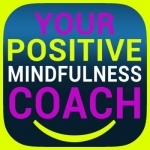
Your Positive Mindfulness Coach - Live positively!
Health & Fitness and Lifestyle
App
Become More Positive and Attract More Happiness into Your Life with ‘Your Positive Mindfulness...
